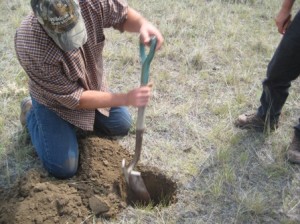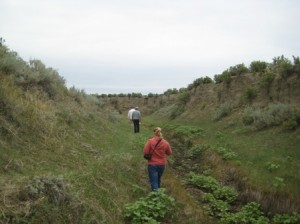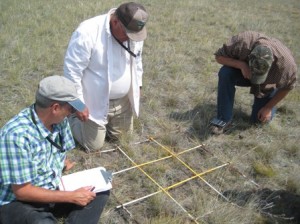Last Wednesday, Charlotte and I finally got to go out with range management. These guys do a lot of habitat surveys and such, and the day we went out was no exception. First were some riparian habitat assessments, where we walked in and around dry stream beds to determine if the waterways were in “pfc”, proper functioning condition. The first part of the pfc assessment is taking a photo from a stake that somebody put at the site a long time ago– the idea is to be able to compare these photos, taken from the same location, to see how the site is changing over time. Then we would walk around and look at things like sinuosity (i believe this is a measure of how meandering the stream is, but i think its a little more complicated than that), evidence of downcutting, bank stability, riparian plant communities, and flow capacity. If they decide a waterway isnt in pfc, they have to make recommendations about how to fix it, so they also have to take into account its potential– for example, one of the sites we visited wasnt in great shape, but there wasnt a whole lot that could be done about it because its flow had been restricted by upstream dams. It was concluded that this site had reached its potential and was therefore in pfc.
After we finished with the riparian assessments, we drove to another site to do an upland habitat assessment. We surveyed a vegetation plot that nobody had looked at since 1989, dug a hole to look at the soil, and compared the plant communities present to the ones that “should” be present according to the big binder of range management stuff. Turns out this spot was not in great shape; after being homesteaded and farmed in the 1930s (and later vacated), club moss and three awn grass grew back in. The club moss is particularly problematic, because it covers the ground, hinders percolation and blocks other grasses from growing in. The result is that the land isnt as productive as it could be in terms of livestock, because cows dont eat club moss. The two ways of getting around this “dead end” succession pattern are fire and tilling (with a plow or a herd of buffalo, but since there are no buffalo…), neither of which can be enacted easily by the BLM, so for now the club moss reigns supreme.

Tom digging a hole to see the soil layers. The topsoil here is very deep. Part of the assessment asks the soil type, which you decide by taking a handful of dirt and getting it wet. If you can make a long ribbon of mud between your thumb and forefinger, the soil has a high clay content. This soil was just silty, but we still got to play with mud, which was cool.


